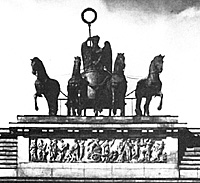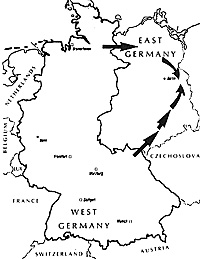 Much ink has been spilled over the possibility of war
between the Warsaw pact and the NATO Alliance. In books and
magazines, on movie and television screens, such a war invariably
begins with a Soviet invasion of West Germany. To blindly assume
such a course is to overlook political reality. West Germany has far
more to gain from invading the East than the Soviets have to gain
from the invasion of the prosperous federal republic.
Much ink has been spilled over the possibility of war
between the Warsaw pact and the NATO Alliance. In books and
magazines, on movie and television screens, such a war invariably
begins with a Soviet invasion of West Germany. To blindly assume
such a course is to overlook political reality. West Germany has far
more to gain from invading the East than the Soviets have to gain
from the invasion of the prosperous federal republic.
The plan for a Bundeswehr invasion of East Germany has been rumored to exist for years. While no concrete invasion plan has ever been divulged, the most common features of the rumored plans show a double envelopment by two spearheads made up of exclusively Bundeswehr troops supported by the three German airborne brigades.
The Southern spearhead would thrust northeastward through the Hof Gap near the East German-Czechoslovak border - the opposite direction of the traditional scenario. The presence of American troops in the gap does more to assure U.S. participation in the event of a Soviet invasion of the West. It also makes it next to impossible for the West Germans to start a war on their own without U.S. approval.
There is apparently no corresponding force on the other side of the border other than the East German border guards. There are considerable Soviet and East German forces just to the north of this invasion route, massed to threaten Fulda from the westernmost part of East Germany. But if these can be successfully screened, the southern panzer spearheads should be able to move forward with no direct opposition until striking a motor rifle division near Frankfurt- on-the-Oder, east of Berlin. Along the way key Soviet airbases could be overrun with little or no ground opposition.
The northern thrust faces a sticker situation. Two enemy divisions face Hamburg directly across the border, opposed by one West German panzergrenadier division in Schleswig-Holstein. While their comrades in the south streak across the plains of Saxony, the northern wing will face heavy fighting almost from the outset. The two border divisions will have to be defeated in the early hours of the invasion and the airbase at Schwerin overrun before reserves can be brought up. After that, there are only minimal enemy forces along the Baltic coast other than the elite East German 29th Motorized Marine Infantry Regiment at Rugen.
The goal of the two wings is not to capture Berlin, but to meet to the east of the capital. There does not necessarily have to be physical contact between the troops; rocket and conventional artillery fire can be used to close the gap.
The central front and the Czech border would be held by allied troops - American, British, Dutch and Belgian. While each government would doubtlessly have powerful objections to such a West German adventure, the troops are already in place, and would have little or no knowledge of why the Soviets were crossing the border in front of them, only that they were and that the allied troops' orders are to prevent such an incursion.
Objective
The objective of the German attack would be to trap the Group of Soviet Forces in Germany to the west of Berlin and force a negotiated settlement at this point in the war, three or four days after its start. The full strength Soviet units would be caught, with reserve divisions in the Soviet Union itself needing many days to mobilize and travel across potentially hostile Polish territory. Soviet doctrine calls for a relentless push forward and Bundeswehr planners apparently reason that this would make it extremely difficult for Soviet generals to turn their troops around and respond to the German attack. Such an invasion would also place the fighting in East Germany rather than in heavily urban and industrial West Germany.
The Bundesmarine would have only a small role to play. The quickness of the attack is designed in part to overcome the massive Soviet naval advantage in the Baltic. The West German coastal submarines could prove useful in protecting the seaward flank of the northern wing from counterattacks by Soviet naval infantry, but the fleet's destroyers and frigates are designed to supplement the British and Dutch anti-submarine and convoy escort roles.
Political Goal
 The political goal of such an assault would be the reunification
of Germany. The economies of both Germanies are at a point where
unification would benefit each country, as young West
Germans seek work appropriate to their education and the East
suffers from a lack of those trained and skilled professionals unable
to find a job in the west. Needless to say, the invasion would not be
undertaken without some connivance on the part of the East
Germans. While active participation by the Volkswehr is extremely
farfetched, orders to remain in barracks and offer no resistance to the
Bundeswehr are easily imaginable.
The political goal of such an assault would be the reunification
of Germany. The economies of both Germanies are at a point where
unification would benefit each country, as young West
Germans seek work appropriate to their education and the East
suffers from a lack of those trained and skilled professionals unable
to find a job in the west. Needless to say, the invasion would not be
undertaken without some connivance on the part of the East
Germans. While active participation by the Volkswehr is extremely
farfetched, orders to remain in barracks and offer no resistance to the
Bundeswehr are easily imaginable.
The military regime of Poland's General Wojchiech Jaruzelski would also have much to gain from a West German victory, and the Polish troops would be very unlikely to counterattack the West German spearheads. Even if the Polish regime were willing, the only reliable troops at its command are those of the party's motor rifle division, but they are needed to control domestic unrest.
The Soviet Union has renounced the first use of nuclear weapons, but a West German attack would surely cause a rethinking of this commitment. The Soviet fear of a German invasion dating from 1941 is not to be underestimated; they have also not forgotten that Imperial Germany brought Russia to its knees in 1917 while holding off practically the whole Western world.
It would be far easier for a Soviet commander to order a nuclear strike on the territory of a Warsaw Pact satellite than in West Germany, with the eyes of the world watching the Soviets liberate the peoples of Europe from capitalist tyranny.
The reaction of Western governments is difficult to predict. Such an invasion would inevitably mean the end of the NATO alliance. If it were successful, a reunited neutral Germany would serve as a buf fer state between East and West, incorporating West and East Germany and possibly some of the territory lost to Poland in 1945. West German Foreign Minister Hans-Dietrich Genscher has made reference to "the borders of 1914" as a basis for permanent peace in Europe. In return for these lands, a neutral and independent Poland would also return to the map of Europe as a guarantee to the Soviets against another German invasion.
With the Spanish committment to NATO already weak at best, Spain could be expected to leave the alliance. Greece and Turkey would surely be at each other almost immediately, especially if escalating Turkish operations against Kurdish rebels cause a Turkish invasion of Iraq. Turkish warplanes have already bombed rebel bases in Iraq, to the chagrin of the Hussein regime fighting desperately to stave off the revolutionary hordes of Iran.
The Italian commitment to NATO is also questionable and in all likelihood would not survive the perception of NATO as an aggressive alliance. The French fear of resurgent German nationalism is second only to the Soviets and French troops can be expected to pull back from the alliance and redeploy along the Rhine almost immediately. The same can be said for the Belgians and the Dutch.
The massive budget deficits piled up by the Reagan administration together with revelations about arms sales to 'moderate" factions in Iran have made the American people far less willing to engage in overseas military adventures than they were only a year ago. German success would insure the withdrawal of all American forces from Central Europe, at German, if not American insistence. A German defeat would place an American government in a no-win situation, unable politically to abandon one of its closest allies, yet unable to support military aggression.
In neutral Austria, a German victory would probably be used to further recent political moves toward an economic union with Hungary, possibly extending to a political union as well. Despite centuries of Hungarian resentment of Austrian control, both nations have been moving closer together in the 1980s, and talk of eco-political union constantly surfaces in the Austrian press.
Back to Table of Contents: CounterAttack #1
To CounterAttack List of Issues
To MagWeb Master Magazine List
© Copyright 1987 by Pacific Rim Publishing Company.
This article appears in MagWeb (Magazine Web) on the Internet World Wide Web.
Other military history articles and gaming articles are available at http://www.magweb.com